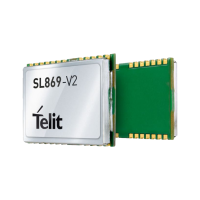resulting in low reflected energy (good return loss), and reject the out-of-band signals by
reflecting it back to the input, resulting in poor return loss.
If an external amplifier is to be used with the receiver, the overall design should be
checked for RF stability to prevent the external amplifier from oscillating. Amplifiers that
are unconditionally stable at the output will function correctly.
If an external filter is to be connected directly to the module, care needs to be used in
making sure the external filter or the internal SAW filter performance is not
compromised. These components are typically specified to operate into 50 ohms
impedance, which is generally true in-band, but would not be true out of band. If there is
extra gain associated with the external filter, then a 6 dB Pi or T resistive attenuator is
suggested to improve the impedance match between the two components.
Input to the LNA (SL869L-V2 AND SL869L-V2S only)
The SL869L-V2 and SL869L-V2S modules add an LNA followed by the post select SAW
filter in the RF path. Thus, the RF input of the module presents a relatively broad and flat
return loss from the LNA. However, out-of-band signals at high level could drive this LNA
into saturation, reducing the performance of the LNA for the desired in-band GNSS
signals.
If an external filter is to be connected directly to the module, care needs to be used in
making sure the external filter or the internal SAW filter performance is not
compromised. These components are typically specified to operate into 50 ohms
impedance, which is generally true in-band. However, unlike the Gen 2 implementation,
a resistive pad would not be required between the external SAW filter and the module.
Powering an External LNA (or active antenna)
An external LNA requires a source of power. Many active antennas accept 3 V or 5 V DC
that is impressed upon the RF signal line.
Two approaches can be used:
1. Use an inductor to tie directly to the RF trace. This inductor should be at self-
resonant at L1 (1.57542 GHz) and should have good Q for low loss. The higher the
inductor Q, the lower the loss will be. The side of the inductor connecting to the
antenna supply voltage should be bypassed to ground with a good quality RF
capacitor, also with self-resonance at the L1 frequency.
2. Use a quarter wave stub in place of the inductor. The length of the stub is designed
to be exactly a quarter wavelength at L1 (1.57542 GHz), which has the effect of

